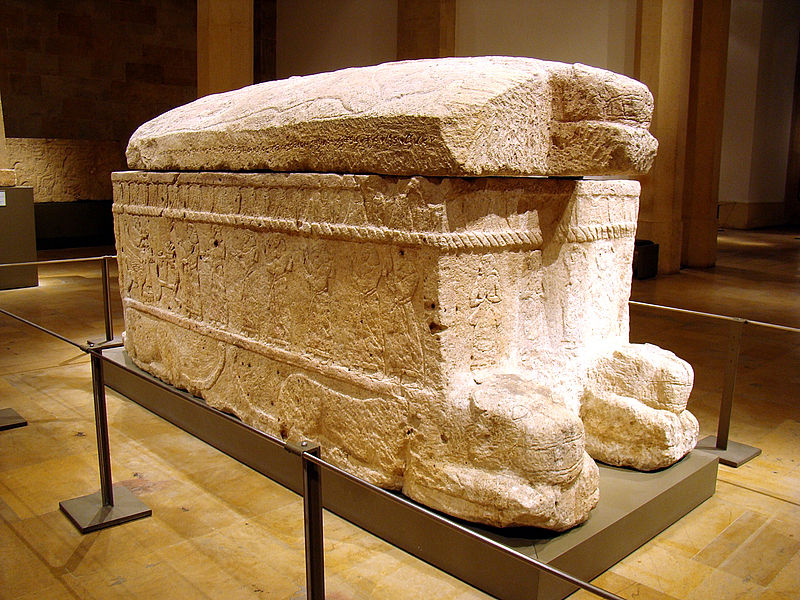Phoenicians lived in the coastal cities of the Levant, north of Palestine. Their language and culture were closely related with the western Semitic languages and cultures of southern Canaan. During the late Bronze Age, Phoenician cities were located in the zone of Egypt control, and the Egyptians had monopoly over almost the whole trade transactions of Phoenicians. During middle of the II Millennium BC, Syria and Phoenicia fall under the rule of Egypt.
Pharaohs of the 18 dynasty conquered Syria all the way to the Euphrates. Pharaohs made all Syrian cities submissive to their power and they imposed tax. At the head of many conquered cities were local people – Dukes who were set on those places by Egyptians.
In XIV century BC, Egypt lost power in Syria and Hittites came on the place of Egyptians. Hittite colonized northern Syria; in the XIV century, Egyptians were forced to surrender their positions Hittites in front of Asia, but soon in Syria appeared new invaders, maritime nations.
When the great empires of the Old East collapsed in the XII century, the Phoenician cities were free of foreign influence. The destruction of Ugarit, who was a knot in the exchange of goods between eastern Anatolia and Syria, has opened up place for the boom of other towns. In IX and VIII century Phoenician cities had primacy over trade in the Mediterranean basin.
Phoenicia never existed as a single state, primarily because of the area in which the cities were. Occasionally the larger centers such as Sidon established authority over the surrounding, smaller cities. Most of the Phoenician cities were independent city – states. They were made on the small islands or on the coast of the Levant. The leading cities in IX and VIII century were Arvad, Sidon and Tyre.
At the end of XII and beginning XI century, a trade was established again between Phoenicia, Cyprus, and the cities of the Philistines, which contributed to the stabilization of the economic situation. Phoenician cultural influence spread to Cyprus, Cilicia, Syria, northern Palestine, Philistia and the delta of the Nile.



In the X century, Tyre has risen as the most important Phoenician city. Originally, Tyre was populated on the mainland, with the island of Tyre just offshore and a much smaller island between the mainland and the larger island. The city was just a minor community and, in fact, had to be founded and re-founded by Sidon. The Old Testament says that the ruler of Tyre Ahiram I also known as Hiram (971-939 BC) formed an alliance with Solomon. Alliance has meant taking joint commercial ventures in the country of Ophir. This alliance has enabled Tyre to access into Israel’s territory, in Damascus and Syria. Solomon handed to Ahiram 20 villages, which were rich in agricultural area, and that allowed Tyre to feed its population. When Ahiram I came to power, he brought massive changes. He had cisterns and other engineering works built to catch and save rainwater (the first known in history). He joined the two islands together with landfill from the mainland (bringing it to about 40 acres) and used some of the soil to enclose, on three sides, the harbor on the north side of the island (and added mighty shipyards). He not only built the royal palace, but great temples to Melkart and Astarte, which were world famous hundreds of years later, when Herodotus wrote of them, and when Alexander wanted to worship in that of Melkart. The building of the Eurychoros (“Broad Place”) is, by tradition, credited to Ahiram. This was the main marketplace near the northern harbor. He put a great deal of diplomatic efforts into his relations with Palestine (making his city the main trading partner for Palestine). Ahiram focused his commercial efforts on the continent of Asia. This not only required the land routes to Asia (through Israel), but a strong presence in the Mediterranean. He produced the strongest commercial/military fleet in the sea. Hiram called himself “King of Tyre and of Phoenicia” but, though it may have been true financially, the actual political reality didn’t happen till his son was on the throne.
Alliance of Tyre and Egypt, and attempt of Sheshonq I to regain Egyptian supremacy in the Levant, had to strengthen the position of Tyre in relation to Israel, Judea and among the Philistines. Tyre, in the middle of the IX century was so strong that even Sidon admitted his hegemony. That is why Ithobaal I (887-856 BC) ruler of Tyre, in the inscriptions is referred to as the king of Sidon, and that title was retained also by his successors.
During the period of prosperity cities Tyre, Sidon and Byblos sent to Assyrian rulers Ashurnasirpal II and Shalmanaser III gifts as a sign of good neighborly relations. This situation lasted throughout the IX century. In the VIII century, Assyrian pressure intensified. Tiglath-Pileser III in 743 BC, territory of north Phoenicia. Tiglath-Pileser III was the first Assyrian king who actually attack Phoenicia. After the fall of several northern Phoenician cities, Tyre quickly surrendered to him. Because of this, Tyre lost less land than the other cities, but Phoenicia as a whole lost Arvad and Byblos. From 734 on, city Tyre also had to submit to the presence of Assyrian inspectors and customs officials. Because of their reports, Tyre’s annual tribute to Assyria jumped up to 150 talents of gold. When Tyrian King Luli rebelled against the Assyrian, Sennacherib, in 701, Tyre ended up losing Sidon, almost all of its mainland holdings, and most of her inhabitants were shipped off to Nineveh. Pro-Assyrian monarchs and governors were given control of the city. All Tyre had left was the island and her mainland suburbs.
Sennacherib in the 700 BC took Sidon from Tyre’s king and he entrusted the city to Assyrian governor. Due to this situation and the large tax, in Sidon in 677 BC the rebellion was brutally crushed by Assyria. Esarhaddon destroyed the city, a territory which was under the direction of Sidon was turned in the province, on the territory of Phoenicia. In 671 BC, a rebellion in Tyre broke out. Since the rebel was quelled in that area was formed province with its center in Ushu.
Somehow, the spirit of independence remained, because Assyria made several more blockades in the 670s and 660s. One of these (663) was by Ashurbanipal, in which he built a land bridge out to the island. He claims to have beaten them and torn down the land-bridge, but some historians think he may have just been bragging. That is how by the end of the Assyrian state existence (612 BC) territory of the former Phoenicia was covered by three Assyrian Province: Simir, Sidon and Ushu. Byblos, and Arvad have retained only vassal status.
In 640, Assyria deprived the city of her mainland suburbs. Even though Tyre had suffered the replacement of its government and most of its people, it maintained its autonomy until the Neo-Babylonian, Nebuchadnezzar, laid siege to it for 13 years, starting in 585. Tyre did not capitulate, but in 570, her king, Ithobaal III, and royal family were deported to Babylon, possibly as a term in the agreement to end the siege. When Ithobaal’s son, Baal II, died in 564, the monarchy ended and the city was put under the control of Babylonian “judges’, which system remained in control through the Persian Empire.
The last siege Tyre endured was that thrust upon it by Alexander the Great. There is considerably more detail about this siege. Because of that and all the fame of his siege of Tyre, I’ll hold this discussion off for a day or two.
